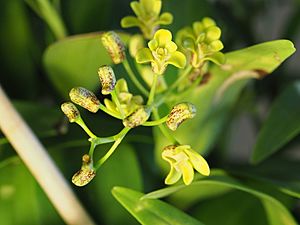Blotched cane orchid facts for kids
Quick facts for kids Blotched cane orchid |
|
|---|---|
 |
|
| Scientific classification | |
| Genus: |
Dendrobium
|
| Species: |
gracilicaule
|
| Synonyms | |
|
|
The blotched cane orchid (scientific name: Dendrobium gracilicaule) is a special type of orchid. It's also called the yellow cane orchid. This plant can grow on other plants, like trees (this is called an epiphyte). It can also grow on rocks (this is called a lithophyte).
This orchid has round, stem-like parts called pseudobulbs. It usually has three to seven thin leaves. Its flowers are often droopy and can be cream, yellow, or greenish. Sometimes, they have reddish-brown spots on the back. There are two main types, or varieties, of this orchid. One grows in Queensland and New South Wales in Australia. The other type is found on some Pacific Islands, including Lord Howe Island.
Contents
About the Blotched Cane Orchid
The Dendrobium gracilicaule is a plant that grows on other plants or rocks. It has yellowish-green pseudobulbs that are about 40 to 100 centimeters (16 to 39 inches) long. These pseudobulbs are about 4 to 13 millimeters (0.16 to 0.51 inches) wide. Each pseudobulb has three to seven leaves at its top.
Leaves and Flowers
The leaves of this orchid are thin and dark green. They are usually about 70 to 130 millimeters (2.8 to 5.1 inches) long and 20 to 40 millimeters (0.79 to 1.57 inches) wide. The part of the plant that holds the flowers is about 50 to 150 millimeters (2.0 to 5.9 inches) long. It can have anywhere from five to thirty flowers.
The flowers are cream-colored, yellow, or greenish. They are about 10 to 16 millimeters (0.39 to 0.63 inches) long and wide. One type of this orchid has big reddish spots on the back of its flowers. The flower parts called sepals are about 7 to 10 millimeters (0.28 to 0.39 inches) long and 3 to 4 millimeters (0.12 to 0.16 inches) wide. They are quite thick. The petals are also about 7 to 10 millimeters (0.28 to 0.39 inches) long and 3 to 4 millimeters (0.12 to 0.16 inches) wide.
The Labellum
The labellum is a special lip-like part of the orchid flower. It is about 7 to 10 millimeters (0.28 to 0.39 inches) long and 5 to 6 millimeters (0.20 to 0.24 inches) wide. It has three parts, called lobes. The two side lobes curve upwards. The middle lobe looks like a kidney and has three wavy lines on it. These orchids usually bloom between July and September.
Naming the Orchid
The Dendrobium gracilicaule was first officially described in 1859. This was done by a scientist named Ferdinand von Mueller. He published his description in a book called Fragmenta phytographiae Australiae. The plant he described was found by William Hill near Moreton Bay.
What the Name Means
The second part of the orchid's scientific name, gracilicaule, comes from two Latin words. Gracilis means "slender" or "thin." Caulis means "stem" or "stalk." So, the name gracilicaule describes the orchid's slender stems.
Different Types of This Orchid
There are two main types, or varieties, of this orchid:
- Blotched Cane Orchid (Dendrobium gracilicaule var. gracilicaule): This type has large reddish-brown spots on the back of its flowers. It usually grows on trees or rocks in rainforests. You can find it from Mount Fox in Queensland down to the Hawkesbury River in New South Wales.
- Yellow Cane Orchid (Dendrobium gracilicaule var. howeanum Maiden): This type does not have spots on the back of its flowers. It grows in damp forests on Lord Howe Island, the Kermadec Islands, Fiji, New Caledonia, and Vanuatu.

